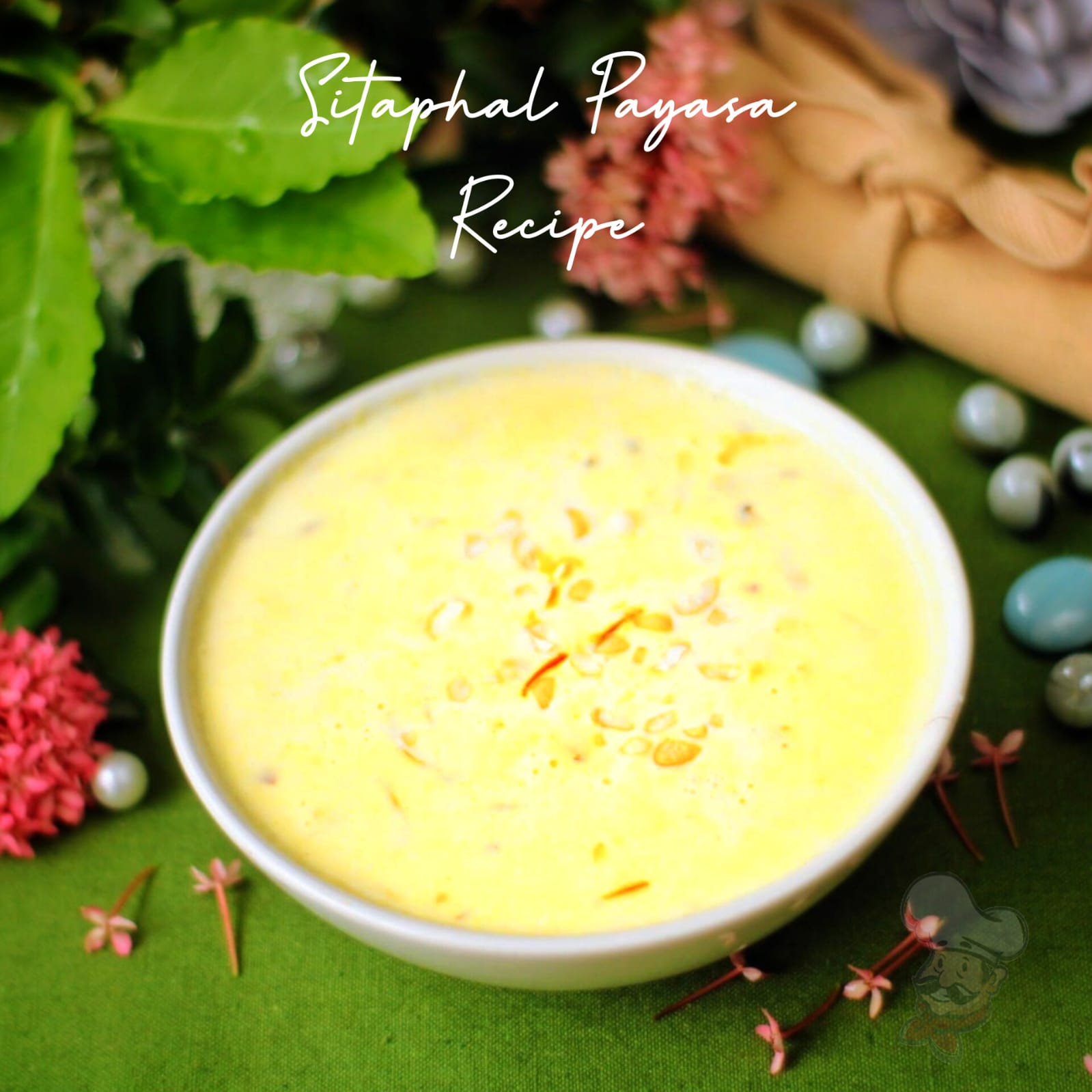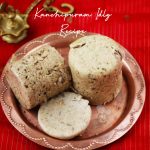Just relish this divine delicacy Sitaphal Payasa that comes with a creamy white sophistication of flavors with the nice heavenly feel of fresh custard apple pulp. Enjoy the unique pulpy taste of sitaphal that takes your palates on a roller coaster ride in every slurp..You will be impressed by its shimmery hue even before you taste it..
Table Of Contents:
1. Sitaphal Payasa
2. A Brief Note On Sitaphal Payasa
3. The Origin And History Of Sitaphal Payasa
4. The Status Of Sitaphal Payasa In Classic Indian Desserts
5. The uniqueness Of Sitaphal Payasa
6. The Biological Facts Of Custard Apple
7. The Health Benefits Of Custard Apple
8. Usage Of Custard Apple In Ancient India
9. Things To Remember
10. Needed Ingredients To Make Sitaphal Payasa
11. Step wise Directions To Make Sitaphal Payasa
12. Faqs
13. Sitaphal Payasa In A Nutshell
14. A Sample Indian Menu That Includes Sitaphal Payasa As A chosen Dessert
15. A Simple Ambience Which You May Like
16. Nutritional Value
17. The Takeaway: The Grandeur Of Classic Indian Desserts With Its Harmony Of Flavors
Sitaphal Payasa, also known as custard apple kheer, is a culinary masterpiece that effortlessly combines the rich heritage of Indian sweets with the delicate and exotic flavor of custard apples. This delectable dessert is a celebration of creamy indulgence and natural sweetness, making it a true delight for the senses. With its heavenly aroma, velvety texture, and a medley of enticing flavors, Sitaphal Payasa is a testament to the creativity and expertise of Indian cuisine. Whether enjoyed warm or chilled, it never fails to leave a lasting impression, making it a cherished treat for special occasions and a testament to the incredible diversity of Indian desserts.
A Brief Note On Sitaphal Payasa:
Sitaphal Payasa, a beloved Indian dessert, is a culinary treasure that harmoniously blends the lusciousness of custard apple (sitaphal) with the richness of milk and the sweetness of sugar. This delightful treat is created by simmering milk to a creamy consistency, adding mashed custard apple pulp for a unique tropical twist, and enhancing the flavor with royal aromatic spices like cardamom and saffron.
Roasted nuts add a delightful crunch, elevating the dish to an indulgent delight. Sitaphal Payasa is a celebration of both flavor and texture, making it a cherished dessert that captivates the taste buds and evokes a sense of nostalgia for those who savor its exquisite taste. Whether served warm or chilled, it's a dessert that embodies the essence of Indian cuisine, bringing joy and satisfaction to anyone fortunate enough to enjoy it in its authentic form.
The Origin And History Of Sitaphal Payasa:
Sitaphal Payasa, also known as custard apple kheer, has its roots in the rich culinary traditions of India. While the exact origin of this dessert is not well-documented, it is a beloved sweet dish that has been prepared and enjoyed in various regions of India for generations. The dish takes its name from "sitaphal," which is the Indian name for custard apples, and "payasa," which means "kheer" or (sweet milk pudding) in Kannada, a South Indian language.
Custard apples themselves have a long history in India and have been cultivated for centuries. Though they are native to South America it was introduced to India and other parts of the world through trade and exploration. The unique, sweet, and creamy texture of custard apples makes them a natural choice for incorporating into desserts.
Indian cuisine has a rich tradition of preparing sweet dishes using milk, sugar, and various flavorings. Kheer or payasa, in particular, is a common dessert made by simmering milk with rice, poha, sooji or vermicelli with sugar and aromatic ingredients like cardamom, saffron, and nuts.
The combination of custard apples and this milk-based dessert likely emerged as a delightful way to incorporate the sweet and fragrant qualities of the fruit into a traditional Indian dessert. Over time, regional variations and personal preferences have contributed to the diversity of sitaphal payasa recipes across different parts of India.
Today, sitaphal payasa remains a popular and cherished dessert, especially during festivals, celebrations, and special occasions. Its sweet, creamy, and fruity flavors continue to delight the taste buds of those who enjoy it, and it has become an integral part of India's culinary heritage.
The Status Of Sitaphal Payasa In Classic Indian Desserts:
The Traditional Indian delight sitaphal payasa, or custard apple kheer, has been a classic and well-loved dessert in Indian cuisine, particularly in South India and some other regions. It has been holding a strong presence in traditional Indian desserts, especially during festivals, special occasions, and feasts since several decades.
The present status of sitaphal payasa in Indian classic desserts has increased significantly since then, as classic recipes tend to endure and retain their popularity over time. However, it's important to note that culinary preferences and trends can evolve, and new improvisations and modifications may enhance its popularity and versatility.
The uniqueness Of Sitaphal Payasa:
The uniqueness and specialty of sitaphal payasa lie in its ability to capture the essence of a tropical delight within a creamy, comforting dessert. Here's what makes it stand out:
Distinctive Flavor: Sitaphal payasa showcases the rare and delightful flavor of custard apples, which is a harmonious blend of tropical fruitiness, reminiscent of banana, pineapple, and strawberry, all in one.
Creamy Texture: Its velvety and indulgent texture is a testament to the mastery of combining milk with the natural richness of custard apple pulp, creating a dessert that's both luxurious and homely.
Fragrant Aroma: The sweet aroma of custard apples infused into the payasa is inviting and evocative, promising a sensory journey that starts even before the first bite.
Traditional Heritage: As a classic Indian dessert, sitaphal payasa embodies the rich cultural heritage of the country, celebrating the use of indigenous fruits in culinary traditions.
Balanced Sweetness: It strikes the perfect balance of sweetness, allowing the custard apples' natural sugars to shine while harmonizing with the creamy milk and spices like cardamom.
Visual Appeal: The dessert's golden hue, often enhanced by saffron strands along with the natural creamy color of milk and condensed milk together, adds to its visual charm, making it a feast for the eyes before it ever reaches the palate.
Versatility: While traditional in its essence, sitaphal payasa also allows for creative variations, such as the addition of nuts or the use of jaggery or palm jaggery for those seeking a healthy twist on tradition.
Simplicity and Elegance: Its simplicity in preparation and elegant presentation make it an accessible yet impressive dessert for both home cooks and professional chefs alike.
Comforting Tradition: As a dessert deeply rooted in Indian culture, sitaphal payasa invokes a sense of nostalgia and comfort, making it a favorite choice for celebrations, festivals, and family gatherings.
- Nutritional Value: Beyond its delightful taste and texture, sitaphal payasa offers nutritional benefits from the custard apples, providing vitamins, minerals, and dietary fiber. In essence, sitaphal payasa is a cherished dessert that captures the essence of India's culinary heritage, offering a uniquely delightful experience that combines the exotic and the familiar in every spoonful.
The Biological Facts Of Custard Apple:
Botanical Classification: Custard apple belongs to the Annonaceae family and is a member of the Annona genus. It is closely related to other fruits like cherimoya (Annona cherimola) and soursop (Annona muricata).
Fruit Description: The custard apple fruit is typically heart-shaped or oval and can vary in size, ranging from about 7 to 12 centimeters in diameter. It has a green, bumpy skin that turns brown as the fruit ripens. The flesh is creamy white and is divided into segments, each containing a black seed.
Habitat: Custard apple trees thrive in tropical and subtropical regions. They are well-suited to warm, humid climates and are commonly found in countries like India, Pakistan, Australia, and various parts of South and Central America.
Cultivation: Custard apple trees are grown from seeds or propagated through grafting. They require well-drained soil and plenty of sunlight to thrive. The fruit is typically harvested when it becomes slightly soft to the touch.
Flowering and Fruiting: The custard apple tree produces fragrant, greenish-yellow flowers that are pollinated by insects, particularly beetles. After pollination, these flowers develop into the fruit, which takes several months to ripen.
Nutritional Content: Custard apples are a good source of dietary fiber, vitamin C, vitamin B6, and various essential minerals like potassium and magnesium. They are also relatively low in calories and fat.
Medicinal Uses: In traditional medicine systems, different parts of the custard apple tree, including the leaves, bark, and seeds, have been used for their potential medicinal properties.
Culinary Uses: Custard apples are primarily eaten fresh, scooping out the sweet, creamy flesh. They are used in various desserts, juices, smoothies, and ice creams. The flavor is often described as a combination of banana, pineapple, and strawberry.
Other Names: Custard apple is known by different names in various regions. It is called "sitaphal" in Hindi and "sharifa" in Urdu.
Conservation Status: Custard apple trees are not considered endangered, but like many fruit trees, they are susceptible to pests and diseases. Proper agricultural practices are essential to ensure their continued cultivation and availability.
The Usage Of Custard Apple In Ancient India:
Culinary Use: Custard apples were commonly consumed as a sweet and flavorful fruit. Their creamy, custard-like texture and unique taste made them a prized fruit in ancient Indian cuisine. They were often eaten fresh, with the flesh scooped out and enjoyed as a dessert or snack.
Desserts: Custard apples were frequently used in the preparation of desserts and sweets. They were added to various milk-based sweets like kheer, ice creams, puddings, milk shakes and also in fruit salads (rice pudding) to enhance flavor and sweetness. The natural sweetness of custard apples made them a favorite ingredient in traditional Indian sweets.
Juices and Beverages: The pulp of custard apples was often used to make refreshing juices and beverages. The sweet and aromatic flavor of the fruit made it an excellent choice for creating thirst-quenching drinks, especially during hot summers.
Medicinal Uses: Different parts of the custard apple tree, including the leaves, bark, and seeds, have been used in various traditional medicine systems in India. They have been believed to have medicinal properties and have been used to treat a range of ailments. For example, custard apple leaves were used to alleviate symptoms of asthma, and the seeds are used as a remedy for diarrhea and dysentery.
Religious and Cultural Significance: Custard apples, like many fruits, held cultural and religious significance in ancient India. They were often offered as a symbol of devotion and as part of religious rituals and ceremonies.
Traditional Healing Practices: In some traditional healing practices like Ayurveda, custard apples were used to balance certain doshas like Vada, pitha and kabha (biological energies) in the body. They were considered to have cooling properties and were used in remedies for conditions associated with excess heat or inflammation.
Nutritional Value: Ancient Indians recognized the nutritional value of custard apples, which provided essential vitamins, minerals, and dietary fiber to their diets.
While the culinary and medicinal uses of custard apples have evolved over time, they have remained a cherished fruit in Indian culture. Even in modern India, custard apples continue to be enjoyed for their delicious flavor and potential health benefits, and they are a popular ingredient in various desserts and beverages.
Health Benefits Of Custard Apple:
Rich in Vitamins and Minerals: Custard apples are a good source of vitamin C, which is an antioxidant that helps boost the immune system and protect cells from oxidative stress. They also contain vitamin B6, which is important for brain health, and various essential minerals like potassium and magnesium.
Dietary Fiber: Custard apples are rich in dietary fiber, which aids digestion and helps prevent constipation. Consuming fiber-rich foods can also contribute to a feeling of fullness, which may assist in weight management.
Heart Health: The potassium content in custard apples can help regulate blood pressure. Maintaining healthy blood pressure levels can reduce the risk of cardiovascular diseases.
Antioxidant Properties: Custard apples contain antioxidants like vitamin C, which can help neutralize harmful free radicals in the body. This antioxidant activity may reduce the risk of chronic diseases and support overall health.
Anti-Inflammatory Effects: Some studies suggest that custard apples may have anti-inflammatory properties, which can be beneficial for reducing inflammation-related conditions in the body.
Aid in Weight Management: The fiber in custard apples can help control appetite and contribute to a feeling of fullness. This can assist in weight management by reducing overall calorie intake.
Improved Digestion: The dietary fiber in custard apples can promote healthy digestion by preventing constipation and supporting regular bowel movements.
Skin Health: The vitamin C content in custard apples is essential for collagen production, which is important for maintaining healthy skin. Adequate vitamin C intake can contribute to a more youthful appearance and may help with wound healing too.
Bone Health: Custard apples contain calcium and phosphorus, which are important minerals for maintaining strong and healthy bones.
Things To Remember:
Do's:
Choose Ripe Custard Apples: Select ripe and fragrant custard apples for the best flavor. Ripe custard apples should have a slightly soft texture when gently pressed.
Wash Thoroughly: Wash the custard apples thoroughly before cutting and extracting the pulp to remove any dirt or impurities.
Mash the Pulp: Mash the custard apple pulp well to remove any seeds or lumps before adding it to the milk.
Use Fresh Ingredients: Use fresh milk, nuts, and other ingredients to ensure the best flavor and texture in your sitaphal payasa.
Stir Frequently: When simmering the milk, stir it frequently to prevent it from sticking to the bottom of the pan and forming a skin on the surface.
Adjust Sugar to Taste: Add sugar gradually and adjust it to your preferred level of sweetness. The sweetness of the payasa should complement the natural sweetness of the custard apples.
Roast Nuts: Roasting the nuts in ghee before adding them to the payasa enhances their flavor and adds a delightful crunch.
Garnish: Garnish the finished payasa with additional nuts and saffron strands for an appealing presentation.
Serve Chilled: While sitaphal payasa can be served at room temperature, it is often more enjoyable when chilled. Refrigerate it for a few hours before serving.
Don'ts:
Don't Overcook the Custard Apple Pulp: Avoid overcooking the mashed custard apple pulp, as it can become too mushy and lose its texture and flavor.
Don't Overload with Custard Apple: While custard apple is the star ingredient, be mindful not to add an excessive amount that may overpower the milk and other flavors.
Don't Use Unripe Custard Apples: Using unripe custard apples can result in a less sweet and less flavorful payasa.
Don't Forget to Remove Seeds: Ensure that you remove all seeds and tough bits from the custard apple pulp before adding it to the payasa.
Don't Boil Milk Too Rapidly: Boil the milk gently to prevent it from scorching or curdling. Stirring frequently helps control the temperature.
Don't Skip the Garnish: The garnish of nuts and saffron strands not only adds visual appeal but also enhances the overall taste and texture of the payasa.
Don't Rush the Process: Making payasa is a slow and gentle process. Avoid rushing through the steps to allow the flavors to meld and develop fully.
By following these dos and don'ts, you can create a delicious and creamy sitaphal payasa that showcases the delightful flavor of custard apples while maintaining the integrity of the dish.
Thus, Custard apple is a delicious tropical fruit with a unique flavor and a rich history of cultivation and consumption in many parts of the world. It is prized for its sweet, custard-like flesh and is enjoyed both for its taste and potential health benefits.

Needed Ingredients To Make Perfect Sitaphal Payasa:
Custard Apples: Custard apples, with their sweet and creamy pulp, are the star ingredient of sitaphal payasa, adding a unique and tropical flavor to the dessert.
Milk: Milk serves as the creamy base of the payasa, providing a luscious and rich texture to the dessert.
Sugar: Sugar is added to sweeten the payasa, and its quantity can be adjusted to suit individual preferences for sweetness.
Chopped Nuts: Chopped nuts like cashews, almonds, and pistachios are toasted in ghee and added to the Sitaphal payasa, imparting a delightful crunch and nutty flavor.
Cardamom Powder: Cardamom powder is used as a spice to infuse the payasa with its aromatic and warm notes, enhancing the overall taste.
Saffron Strands (optional): Saffron strands, when soaked and added to the payasa, lend a beautiful golden hue and a subtle floral aroma to the dessert, elevating its presentation and fragrance.
- Condensed Milk: It is added to enhance the overall flavor and consistency of sitaphal payasa.
Step wise Directions To Make Sitaphal Payasa:
Prepare the Custard Apples: Start by washing and halving the ripe custard apples, then carefully remove the seeds and scoop out the sweet pulp.
Boil the Milk: In a heavy-bottomed pan, bring milk to a gentle boil, ensuring it doesn't scorch, and continue simmering until it thickens and reduces.
Add the Custard Apple Pulp: Incorporate the mashed custard apple pulp into the thickened milk, allowing their flavors to meld and create a harmonious blend.
Sweeten with Sugar and condensed Milk: Gradually add sugar to the mixture, stirring to dissolve and achieving the desired level of sweetness.
Infuse with Cardamom: Enhance the aroma by sprinkling cardamom powder into the payasa, infusing it with warm and aromatic notes.
Roast and Add Nuts: Toast chopped nuts in ghee until golden brown, then introduce them to the payasa for a delightful crunch and nutty flavor.
Saffron Infusion: Soak saffron strands in warm water or milk and add this aromatic infusion to the payasa, creating a visually appealing golden hue and subtle floral notes.
Simmer to Desired Consistency: Let the payasa simmer a bit longer until it reaches your preferred thickness, ensuring all the flavors are well-incorporated.
Chill and Garnish: If desired, refrigerate the payasa until cold, and before serving, garnish with more nuts and saffron strands for an elegant presentation.
Serve and Enjoy: Serve the sitaphal payasa to delight your taste buds with its creamy texture and the unique, sweet taste of custard apples.
Start by washing the custard apples thoroughly. Cut them in half and remove the seeds and skin. You should have just the pulp of the custard apples. Mash the custard apple pulp using a fork or your fingers to remove any lumps. Set it aside.
In a heavy-bottomed pan, pour in half a liter of full fat milk and boil it. Keep stirring it occasionally to prevent it from sticking to the bottom of the pan. Once the milk comes to a boil, reduce the heat to low and let it simmer for about 15-20 minutes. Keep stirring frequently to avoid forming a skin on the top of the milk. Continue simmering until the milk reduces to about half its original quantity and thickens.
Add the sugar and cardamom powder to the mixture. Stir well until the sugar dissolves completely. Taste and adjust the sugar if needed. Then gently squirt in the measured quantity of condensed milk and stir in. Add the dry fruits at this stage so that they soften in boiled milk.
Add the mashed custard apple pulp to the thickened milk. Mix well and continue to cook for another 5-7 minutes, stirring constantly.
While using saffron strands, soak them in a tablespoon of warm water or milk for a few minutes. Then, add the saffron-infused milk to the payasa for a beautiful color and aroma. Let it continue to boil in low flame for five more minutes.
Once the payasa reaches your desired consistency, remove it from the heat and let it cool to room temperature.
You can serve sitaphal payasa chilled or at room temperature. Refrigerate it for a few hours before serving if you prefer it cold.
Garnish with additional nuts and saffron strands if desired before serving.
Faqs On Sitaphal Payasa:
What is sitaphal payasa?
Sitaphal payasa, also known as custard apple kheer, is a traditional Indian dessert made by simmering custard apple pulp with milk and sugar. It is known for its creamy texture and unique fruity flavor.
Can I use canned custard apple pulp for making sitaphal payasa?
While fresh custard apples are preferred for their flavor and texture, you can use canned custard apple pulp as a convenient alternative if fresh ones are not available.
How do I choose ripe custard apples for making payasa?
Ripe custard apples should have a slightly soft texture when gently pressed. Their skin may also turn from green to little brown, and they should emit a fragrant aroma.
Can I use condensed milk instead of regular milk in sitaphal payasa?
Yes, you can substitute condensed milk for regular milk to make the payasa richer and sweeter. Adjust the quantity based on your sweetness preference and let the sweetness be subtle in this payasa so that you enjoy the taste of sitaphal to the fullest.
What are some variations of sitaphal payasa?
Some variations include adding grated coconut for extra flavor, using jaggery instead of sugar for a traditional touch, or incorporating other spices like cinnamon for a unique twist.
Is it necessary to remove custard apple seeds thoroughly before adding the pulp to the payasa?
Yes, it's essential to remove the all the seeds as they are not edible and can affect the texture of the dessert even if there are one or two.
Can I make sitaphal payasa in advance?
Yes, you can prepare sitaphal payasa in advance and refrigerate it. It can be served chilled or at room temperature.
How long does sitaphal payasa stay fresh in the refrigerator?
Sitaphal payasa can be stored in the refrigerator for one or two days approximately. Make sure to cover it well to prevent it from absorbing other odors. But as much as possible finish it off in a day to get the maximum taste and nutritional benefit.
Sitaphal Payasa In A Nutshell:
- Nature: Dessert
- Color: Creamy
- Texture: Smooth
- Consistency: Velvety
- Aroma: Fragrant
- Taste: Sweet
- Flavor: Fruity
A Sample Indian Menu That Includes Sitaphal Payasa As A chosen Dessert:
Appetizers:
- Vegetable Samosas: Crispy pastry filled with spiced potatoes and peas.
- Paneer Tikka: Marinated and grilled cubes of paneer (Indian cottage cheese).
- Papdi Chaat: A savory snack made with crispy fried dough wafers topped with yogurt, chutney, and spices.
Main Courses:
4. Chicken Tikka Masala: Tender chicken pieces in a creamy tomato-based sauce.
- Chana Masala: Spicy chickpea curry cooked with aromatic spices.
- Jeera Rice: Fragrant basmati rice cooked with cumin seeds.
- Garlic Naan: Soft and garlicky Indian bread.
Sides:
8. Cucumber Raita: Cooling yogurt with cucumber and spices.
- Mixed Vegetable Sabzi: A medley of seasonal vegetables in a flavorful gravy.
- Aloo Paratha: Stuffed flatbread with spiced potato filling.
Dessert: 11. Sitaphal Payasa: Creamy custard apple kheer with saffron and roasted nuts.
A Simple Ambience Which You May Like:
Creating a homely and simple ambiance for hosting a dinner with sitaphal payasa involves setting a warm and welcoming atmosphere where your guests can feel comfortable and relaxed. Here are some ideas:
Table Setting: Use a clean and well-arranged dining table with simple tableware like white or earth-toned plates, minimal cutlery, and cloth napkins. Avoid overly formal or elaborate settings.
Lighting: Opt for soft, warm lighting with candles or fairy lights to create a cozy and intimate atmosphere. Dim the lights slightly to set the mood.
Decor: Keep decorations minimal and natural. Fresh flowers in a simple vase, potted plants, or a small centerpiece can add a touch of homeliness.
Music: Play soft and soothing background music at a low volume to enhance the ambiance. Choose calming instrumental music or acoustic melodies.
Seating: Arrange seating to encourage conversation. Use comfortable chairs or cushions on the floor for a relaxed and informal feel.
Crockery and Serveware: Use homely, handcrafted or rustic-style crockery and serveware to give the dinner a down-to-earth touch.
Takeaway: The Grandeur Of Classic Indian Desserts With A Harmony Of Flavors Including Sitaphal Payasa:
In the realm of desserts, sitaphal payasa stands as an exquisite testament to the harmonious fusion of nature's bounty and culinary creativity. With its lush creaminess and tropical charm, it sweeps us away to a realm of pure delight, where each spoonful reveals the essence of custard apples' sweet embrace. Its fragrant aroma beckons us to savor the simple pleasures of life, and its velvety texture envelops our senses in a warm and comforting embrace. In the world of Indian sweets, sitaphal payasa is a timeless masterpiece, a sweet symphony that dances on the palate and lingers in the heart, reminding us of the profound beauty found in the simplest of joys.
The grandeur of great Indian milk desserts is a testament to the rich tapestry of flavors and culinary traditions that have thrived in the Indian subcontinent for centuries. These desserts, often crafted with skill and patience, are celebrated for their exquisite taste and harmonious blending of ingredients. At the heart of these creations is milk, a symbol of purity and abundance in Indian culture, which serves as the canvas upon which a symphony of flavors is painted.
From the iconic sweetness of Gulab Jamun to the creamy richness of Rabri and the fragrant indulgence of Rasgulla, these desserts evoke a sense of nostalgia and comfort, transcending boundaries and uniting people from diverse backgrounds. Each dessert tells a story of regional variations, cultural influences, and cherished family recipes passed down through generations.
What sets these milk desserts apart is their remarkable ability to balance flavors, often with a touch of aromatic spices like cardamom and saffron, creating a sensory journey that is both comforting and celebratory. Whether enjoyed during festivals, special occasions, or as a sweet ending to a daily meal, these desserts have an enduring place in the hearts and palates of those who savor their grandeur.
In their grandeur, these milk-based sweets are more than just culinary delights; they are a celebration of India's culinary diversity, a testament to the country's love affair with dairy, and a reminder of the simple pleasures found in the harmonious interplay of flavors. And we are fortunate enough and blessed to explore these treasured recipes passed on through generations from our ancestors.
Ingredients
Directions
Start by washing the custard apples thoroughly. Cut them in half and remove the seeds and skin. You should have just the pulp of the custard apples. Mash the custard apple pulp using a fork or your fingers to remove any lumps. Set it aside.
In a heavy-bottomed pan, pour in half a liter of full fat milk and boil it. Keep stirring it occasionally to prevent it from sticking to the bottom of the pan. Once the milk comes to a boil, reduce the heat to low and let it simmer for about 15-20 minutes. Keep stirring frequently to avoid forming a skin on the top of the milk. Continue simmering until the milk reduces to about half its original quantity and thickens.
Add the sugar and cardamom powder to the mixture. Stir well until the sugar dissolves completely. Taste and adjust the sugar if needed. Then gently squirt in the measured quantity of condensed milk and stir in. Add the dry fruits at this stage so that they soften in boiled milk.
Add the mashed custard apple pulp to the thickened milk. Mix well and continue to cook for another 5-7 minutes, stirring constantly.
While using saffron strands, soak them in a tablespoon of warm water or milk for a few minutes. Then, add the saffron-infused milk to the payasa for a beautiful color and aroma. Let it continue to boil in low flame for five more minutes.
Once the payasa reaches your desired consistency, remove it from the heat and let it cool to room temperature.
You can serve sitaphal payasa chilled or at room temperature. Refrigerate it for a few hours before serving if you prefer it cold.
Garnish with additional nuts and saffron strands if desired before serving.








